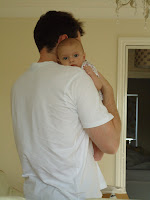As soon as your baby’s born you’ll be invited to enroll in some baby’s groups where you can learn from health visitors and other mum’s . Some of the topics they will discuss are baby development, immunization, sleep, baby’s food etc. However, they will not discuss how to treat cold and flu and before you know it your baby will have a cold or flu. This is partly caused by the group environment being the perfect place to pass on infections and also being out and about with your newborn in a pushchair will expose them to pollution from streets, cars etc.. You need to remember your baby doesn’t have a built in defence against these.
In this case, the best thing you can do it is prepare yourself to deal with the situation because you can’t be over protective. Remember getting some of these bugs will help your baby’s immune system become resistant.
To be prepare you should get yourself some of the anti-cold and flu items from the supermarket. These are:
1) A warn humidifier or facial sauna
2) A thermometer
3) Saline drops
4) Calpol or Neurofren
5) Karvol nasal decongestant
6) Something to lift your baby’s cot
7) Very soft tissues
The above list are the most essential items you can buy to help your baby get rid of cold and flu and you won’t always use all of them. For example if your baby gets a cold with a runny or blocked nose and suffers tiredness you might try the warn humidifier or facial sauna, saline drops, lifting the cot (so baby can sleep better at night), and if baby’s nose is very blocked you might use some tissues. The thermometer and medication might only be used if baby has a flu which includes other symptoms such as a temperature, tears, refusing feeding etc .
What you should do when you observe you baby is starting to get a cold or flu?
You should using the warn humidifier or facial sauna as soon as you can. Any doctor will recommend you to put your baby’s face close to a facial sauna and this should be done as an adult does. I find this is a very popular thing and lots of people already have one at home so you can use it as long as you take care to wash it very well by sterilizing the plastic pieces with a hot water and wiping it with alcohol gel.
To use the facia sauna try putting in clean water and switching it on on a low place or even on the floor. When the water starts to boil and steam comes out, hold your baby facing the sauna in a way so that he is getting the steam in his face but not touching the whole thing or burning his face. Let him breath as much as is possible because this is what will help the bad symptoms come out during the day. You can do this as often as you want during the day and also at night. At night switch it on in your baby’s room on the floor close to the cot. If you have a warn humidifier, you will find is even better because you switch it on in the room where you baby is, close the door and let the steam fulfil the whole room. Be careful as you use this to make sure that after exposing baby to the hot temperature that you don’t go somewhere cool or wipe your baby’s forehead with cold water etc. It can be very dangerous to change the temperature quickly even during the day. Remember babies are very sensitive.
While doing this, always have some tissues around and clean your baby’s nose pressing gentle from up to down cleaning out all the mucus.
If when listening to baby’s breathing you sense they are full of catarrh you should try the saline drops. When using drops remember to do one nostril first and the second nostril five minutes later. NEVER put both at once otherwise the mucus accumulates in the back of his throat blocking the airways. There are different brands of saline drops on the market and after trying a range of them I found the best one is the Calpol Spray. This is exactly because it has a spray function and one thing we know is that babies don’t like things in their nose and won’t keep themselves still for you to try.
For the same reason, if your case baby has a temperature and you need to use Calpol get a syringe to avoid fighting with the spoon. Neurofren does come with a syringe which is a help but Calpol doesn’t. Some mums ask if they should give Calpol or Neurofren and what is the best? I personally think Neurofren is the best because it has a more acceptable flavour for babies and a deep and longer effect like a pain killer. However, Calpol has a fast effect but can be used without worry if your baby has asthma or eczema. Neurofren can’t be used if your baby has asthma or eczema and if you suspect these conditions the its better to use Calpol in a very young child. NEVER give your child both Calpol and Neurofren, neither together nor after 2 hours, nor after two days. Do not give your child any medication before reading and understanding the label. Remember if the symptoms don’t disappear book an appointment with a Doctor.

